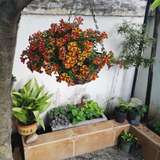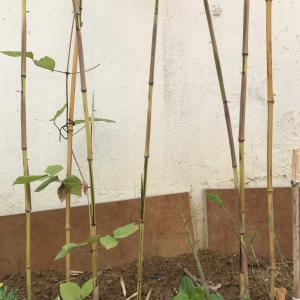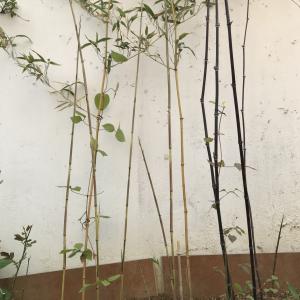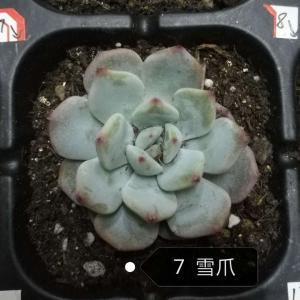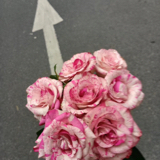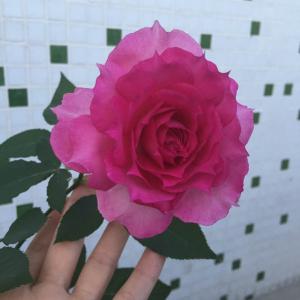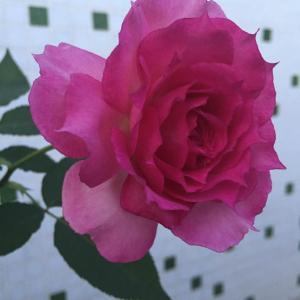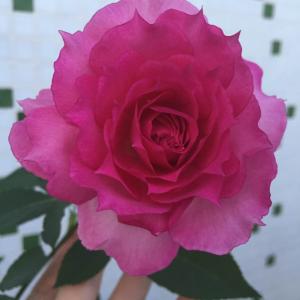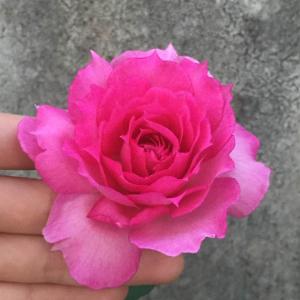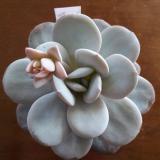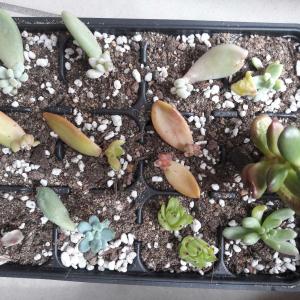文章
Miss Chen
2018年05月18日

Description: This herbaceous perennial plant is 1–2½' tall, branching occasionally. The central stem is terete, hairless, and usually light green (less often purplish green or purple). The alternate leaves are up to 7" long and 3½" across. They are light green or greyish green and hairless with a soft floppy texture. The leaves are ovate-oval or ovate-oblong in shape, smooth (entire) along their margins, and pinnately veined. The leaves usually taper to winged petioles up to 2½" long, although some of the upper leaves are sessile. The upper stems terminate in nodding cymes of flowers. Individual flowers are about ¾–1¼" in length.
The corolla of each flower is tubular at its base, but it is more bell-shaped (campanulate) toward its outer rim, where there are 5 shallow lobes that are barely discernible. Inserted within the corolla, there are 5 white stamens with light brown anthers and a white style that is long and slender. The small greyish green calyx of each flower is about ¼" (6 mm.) long; it is divided into 5 elliptic teeth. The flower buds are pink, bluish pink, or purple, while the corollas of mature flowers are light blue (rarely white or pink). The pedicels of the flowers are greyish green to purple, terete, and up to ¼" (6 mm.) long. The blooming period occurs from mid- to late spring, lasting about 3 weeks. Afterwards, the flowers are replaced by 4-lobed fruits (schizocarps), which contain the nutlets (4 nutlets per flower). The small nutlets are dark brown, ovoid, and flattened on one side; their surfaces are minutely wrinkled or pitted. The root system consists of a taproot. This plant often forms colonies.
Cultivation: The preference is light shade to partial sun in moist areas with rich loamy soil. This plant develops very quickly during the spring after danger of hard frost has passed. Its foliage dies down by mid-summer.

Range & Habitat: Virginia Bluebells is a fairly common plant that occurs in most counties of Illinois (see Distribution Map), where it is native. Habitats include floodplain woodlands, bottomland woodlands, mesic woodlands, and wooded bluffs. Sometimes this wildflower forms sizable colonies in semi-shaded floodplain areas along rivers or streams, where it often competes with Wood Nettle (Laportea canadensis). It is also cultivated in flower gardens.
Faunal Associations: The flowers are cross-pollinated by long-tongued bees primarily, including honeybees, bumblebees, Anthophorid bees (Anthophora spp., Synhalonia spp.), and mason bees (Osmia spp.); these insects obtain nectar and/or collect pollen. Other visitors of the flowers include the Giant Bee Fly (Bombylius major), butterflies, skippers, and Sphinx moths, including a hummingbird moth (Hemaris thysbe). This group of visitors suck nectar from the flowers. Halictid bees and Syrphid flies sometimes visit the flowers, but they are too small in size to be effective pollinators. In some areas, the Ruby-Throated Hummingbird has been observed to visit the flowers. White-Tailed Deer browse on the foliage occasionally during the spring. When this plant forms large colonies, it provides protective cover for many kinds of wildlife during the spring.

Photographic Location: A moist wooded area of Busey Woods in Urbana, Illinois.
Comments: It is easy to see why Virginia Bluebells (Mertensia virginica) is a favorite woodland wildflower. The pastel colors of the flowers and foliage are soft and soothing. There are other Mertensia spp. in the United States with a similar appearance, but they occur north or west of Illinois. They usually have smaller flowers and/or pubescent foliage.
The corolla of each flower is tubular at its base, but it is more bell-shaped (campanulate) toward its outer rim, where there are 5 shallow lobes that are barely discernible. Inserted within the corolla, there are 5 white stamens with light brown anthers and a white style that is long and slender. The small greyish green calyx of each flower is about ¼" (6 mm.) long; it is divided into 5 elliptic teeth. The flower buds are pink, bluish pink, or purple, while the corollas of mature flowers are light blue (rarely white or pink). The pedicels of the flowers are greyish green to purple, terete, and up to ¼" (6 mm.) long. The blooming period occurs from mid- to late spring, lasting about 3 weeks. Afterwards, the flowers are replaced by 4-lobed fruits (schizocarps), which contain the nutlets (4 nutlets per flower). The small nutlets are dark brown, ovoid, and flattened on one side; their surfaces are minutely wrinkled or pitted. The root system consists of a taproot. This plant often forms colonies.
Cultivation: The preference is light shade to partial sun in moist areas with rich loamy soil. This plant develops very quickly during the spring after danger of hard frost has passed. Its foliage dies down by mid-summer.

Range & Habitat: Virginia Bluebells is a fairly common plant that occurs in most counties of Illinois (see Distribution Map), where it is native. Habitats include floodplain woodlands, bottomland woodlands, mesic woodlands, and wooded bluffs. Sometimes this wildflower forms sizable colonies in semi-shaded floodplain areas along rivers or streams, where it often competes with Wood Nettle (Laportea canadensis). It is also cultivated in flower gardens.
Faunal Associations: The flowers are cross-pollinated by long-tongued bees primarily, including honeybees, bumblebees, Anthophorid bees (Anthophora spp., Synhalonia spp.), and mason bees (Osmia spp.); these insects obtain nectar and/or collect pollen. Other visitors of the flowers include the Giant Bee Fly (Bombylius major), butterflies, skippers, and Sphinx moths, including a hummingbird moth (Hemaris thysbe). This group of visitors suck nectar from the flowers. Halictid bees and Syrphid flies sometimes visit the flowers, but they are too small in size to be effective pollinators. In some areas, the Ruby-Throated Hummingbird has been observed to visit the flowers. White-Tailed Deer browse on the foliage occasionally during the spring. When this plant forms large colonies, it provides protective cover for many kinds of wildlife during the spring.

Photographic Location: A moist wooded area of Busey Woods in Urbana, Illinois.
Comments: It is easy to see why Virginia Bluebells (Mertensia virginica) is a favorite woodland wildflower. The pastel colors of the flowers and foliage are soft and soothing. There are other Mertensia spp. in the United States with a similar appearance, but they occur north or west of Illinois. They usually have smaller flowers and/or pubescent foliage.
0
0
文章
Miss Chen
2018年05月13日

Description: This small perennial orchid produces a low rosette of evergreen basal leaves. Individual leaves are 1½-2½" long and ¾-1½" across; they are ovate or broadly elliptic and smooth along their margins. There are 5-7 primary veins per leaf; they are parallel. These veins are interconnected through a network of secondary veins. Both the primary and secondary veins are accented in white, while the remaining leaf surface is dark green. The basal leaves taper abruptly to petiole-like bases that are short and winged, where they are also accented in white along their central veins. After several years, a spike-like raceme of flowers develops from the basal rosette that is 4-14" tall and more or less erect. The central stalk of this inflorescence is light green, glandular-pubescent, and terete. Along the lower two-thirds of its length, there are widely separated leafy bracts. These bracts are small in size (about ½" in length), linear-lanceolate in shape, and ascending to erect. Along the upper one-third of the central stalk, the small flowers are densely distributed, facing in all directions.
The sepals and petals of these flowers (3 of each per flower) are white or greenish white, while their inferior ovaries are green and glandular-pubescent. The upper sepal and 2 lateral petals of each flower are merged together to form a hood with a slightly upturned outer rim, while the 2 lateral sepals are free and the lower petal forms an open pouch with a minute down-turned beak. These petals and sepals are 3.5-5.5 mm. long; the outer surfaces of the hood and lateral sepals are minutely pubescent. The ovaries are 6-8 mm. long, ellipsoid in shape, and ascending. At the bases of the ovaries, there are ascending floral bracts. These bracts are green, glandular-pubescent, linear-lanceolate in shape, and ascending; they are about the same length as the ovaries. The blooming period occurs during mid- to late summer, lasting about 3-4 weeks. There is no noticeable floral fragrance. Afterwards, the flowers are replaced by seed capsules that become ovoid in shape and brown at maturity. At this time, these capsules split open into several sections to release their minute seeds to the wind. The root system consists of a shallow creeping rhizome with coarse fibrous roots. After flowering, this rhizome forms 1-3 clonal offsets. The clonal offsets become independent on their rhizomes, while the original rhizome dies. The evergreen basal leaves persist for at least 1½ years (at least 2 summers and 1 winter).

Cultivation: The preference is medium shade to dappled sunlight, mesic to dry-mesic conditions, and an acidic loose soil that contains loam, loess (wind-blown silt from a prior ice age), or glacial till with decaying organic matter. The site should be protected from drying winds and it should be relatively humid. The root system of this orchid benefits from an endomycorrhizal association with certain kinds of fungi. This orchid has been successfully cultivated indoors in terrariums (Ugiansky, 2010). It should not be collected from the wild, which can easily destroy local populations.
Range & Habitat: The native Downy Rattlesnake-Plantain is uncommon in Illinois, occurring mostly in northern and southern Illinois (see Distribution Map). Habitats include upland woodlands, north-facing wooded slopes, bluffs, large wooded ravines or sandstone canyons, sandstone glades, and woodlands damaged by logging. On rare occasions, this orchid has also been found in forested bogs. It is often associated with such canopy trees as oaks, pines, Eastern Hemlock (Tsuga canadensis), or sugar maple (Acer saccharum). This orchid usually occurs in high Faunal Associations: The small flowers are cross-pollinated by bees, including bumblebees (Bombus spp.) and green metallic bees (e.g., Augochlora spp., Augochlorella spp.); see ILPIN and Homoya (1993) for more information. Aside from this, little is known about floral-faunal relationships for this orchid. The evergreen leaves may be browsed by deer and the rhizomes may be eaten by chipmunks or mice, but additional study of such potential threats is required.
Photographic Location: A rocky bluff dominated by Eastern Hemlock (Tsuga canadensis) at a nature preserve in east-central Indiana.
Comments: While the flowers of Downy Rattlesnake-Plantain are rather small, the reticulated patterns of its basal leaves are very ornate and unique, making this orchid easy to identity. In spite of its common name, this orchid is not closely-related to plantains (Plantago spp.); its leaves have a shape that is similar to some of the common broad-leaved plantains. The common name is also inspired by the superficial resemblance of the leaves' reticulated patterns to the skin of a rattlesnake. The inflorescence of Downy Rattlesnake-Plantain resembles those of the Lady Tresses' Orchids (Spiranthes spp.), although they have dissimilar leaves. The flowers of the former orchid differ from those of the latter by the pouch-like structure of their lower lips, which is lacking in the flowers of Lady Tresses' Orchids. There are other orchid species in the Goodyera genus, but their ranges are located outside of Illinois, mostly to the north or northeast.
The sepals and petals of these flowers (3 of each per flower) are white or greenish white, while their inferior ovaries are green and glandular-pubescent. The upper sepal and 2 lateral petals of each flower are merged together to form a hood with a slightly upturned outer rim, while the 2 lateral sepals are free and the lower petal forms an open pouch with a minute down-turned beak. These petals and sepals are 3.5-5.5 mm. long; the outer surfaces of the hood and lateral sepals are minutely pubescent. The ovaries are 6-8 mm. long, ellipsoid in shape, and ascending. At the bases of the ovaries, there are ascending floral bracts. These bracts are green, glandular-pubescent, linear-lanceolate in shape, and ascending; they are about the same length as the ovaries. The blooming period occurs during mid- to late summer, lasting about 3-4 weeks. There is no noticeable floral fragrance. Afterwards, the flowers are replaced by seed capsules that become ovoid in shape and brown at maturity. At this time, these capsules split open into several sections to release their minute seeds to the wind. The root system consists of a shallow creeping rhizome with coarse fibrous roots. After flowering, this rhizome forms 1-3 clonal offsets. The clonal offsets become independent on their rhizomes, while the original rhizome dies. The evergreen basal leaves persist for at least 1½ years (at least 2 summers and 1 winter).

Cultivation: The preference is medium shade to dappled sunlight, mesic to dry-mesic conditions, and an acidic loose soil that contains loam, loess (wind-blown silt from a prior ice age), or glacial till with decaying organic matter. The site should be protected from drying winds and it should be relatively humid. The root system of this orchid benefits from an endomycorrhizal association with certain kinds of fungi. This orchid has been successfully cultivated indoors in terrariums (Ugiansky, 2010). It should not be collected from the wild, which can easily destroy local populations.
Range & Habitat: The native Downy Rattlesnake-Plantain is uncommon in Illinois, occurring mostly in northern and southern Illinois (see Distribution Map). Habitats include upland woodlands, north-facing wooded slopes, bluffs, large wooded ravines or sandstone canyons, sandstone glades, and woodlands damaged by logging. On rare occasions, this orchid has also been found in forested bogs. It is often associated with such canopy trees as oaks, pines, Eastern Hemlock (Tsuga canadensis), or sugar maple (Acer saccharum). This orchid usually occurs in high Faunal Associations: The small flowers are cross-pollinated by bees, including bumblebees (Bombus spp.) and green metallic bees (e.g., Augochlora spp., Augochlorella spp.); see ILPIN and Homoya (1993) for more information. Aside from this, little is known about floral-faunal relationships for this orchid. The evergreen leaves may be browsed by deer and the rhizomes may be eaten by chipmunks or mice, but additional study of such potential threats is required.
Photographic Location: A rocky bluff dominated by Eastern Hemlock (Tsuga canadensis) at a nature preserve in east-central Indiana.
Comments: While the flowers of Downy Rattlesnake-Plantain are rather small, the reticulated patterns of its basal leaves are very ornate and unique, making this orchid easy to identity. In spite of its common name, this orchid is not closely-related to plantains (Plantago spp.); its leaves have a shape that is similar to some of the common broad-leaved plantains. The common name is also inspired by the superficial resemblance of the leaves' reticulated patterns to the skin of a rattlesnake. The inflorescence of Downy Rattlesnake-Plantain resembles those of the Lady Tresses' Orchids (Spiranthes spp.), although they have dissimilar leaves. The flowers of the former orchid differ from those of the latter by the pouch-like structure of their lower lips, which is lacking in the flowers of Lady Tresses' Orchids. There are other orchid species in the Goodyera genus, but their ranges are located outside of Illinois, mostly to the north or northeast.
0
0
Finncarter
2018年05月13日

Notocactus Haselbergii:
- This suoer spikey cactus coverd, has bright red blooms during mid to late spring. A single cactus of its sort can produce up to 6-7 flowers a year, this plant is also very easy to cross-pollenate.
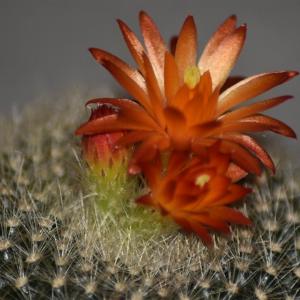
- This suoer spikey cactus coverd, has bright red blooms during mid to late spring. A single cactus of its sort can produce up to 6-7 flowers a year, this plant is also very easy to cross-pollenate.

1
0
文章
Miss Chen
2018年05月11日

Description: This annual plant is up to 1' long and sparingly branched. Its slender stems are glabrous and sprawling to erect. The alternate leaves are up to 3" long and 2" across; they are pinnately compound with 3-7 narrow leaflets. Each leaflet is linear-oblong, smooth along the margins, and hairless.Close-up of Flower Occasionally, a leaflet may be cleft into 2-3 narrow lobes. Both the stems and leaves are light green and rather mossy in appearance. Individual flowers develop from the axils of the upper leaves. Each flower is about ¼" across, consisting of 3 green sepals, 3 white petals, 6 stamens (usually), and a single style. The sepals are lanceolate-ovate and much larger than the petals. The petals are narrowly oblong and inconspicuous. The slender pedicel of each flower is about 1" long. The blooming period occurs from mid- to late spring and lasts about a month. During the heat of summer, the foliage turns yellow and quickly withers away. Each flower develops 1-3 carpels that are globoid and bumpy across the upper surface. The carpels are initially pale green or pale yellow, but they later turn brown and release the seeds. The root system consists of a slender branching taproot. This plant spreads by reseeding itself, and it often form colonies at favorable sites.
Cultivation: The preference is diffuse sunlight to light shade during the spring when vegetative growth and development occurs, otherwise it can be quite shady. The soil should be consistently moist and loamy or silty. This plant doesn't like to dry out.
Range & Habitat: The native False Mermaid occurs occasionally in northern and east central Illinois, otherwise it is rare or absent (see Distribution Map). Habitats include moist to mesic deciduous woodlands and low-lying areas along springs and small rivers in wooded areas. False Mermaid is usually found in high quality woodlands where the original flora is still intact. This is one of the spring wildflowers in woodlands that is threatened by the invasion of Alliaria petiolata (Garlic Mustard).
Faunal Associations: The small inconspicuous flowers can attract flower flies and small bees. The foliage is not known to be toxic and may be edible to mammalian herbivores, although little is known about floral-faunal relationships for this species.
Photographic Location: A moist area of Busey Woods in Urbana, Illinois.

Comments: This inconspicuous little plant is easy to overlook, except where it occurs in sizable colonies along the woodland floor. The delicate foliage is attractive and resembles moss or a Galium sp. (Bedstraw). It isn't immediately obvious when False Mermaid is blooming as the flowers are inconspicuous – careful inspection at the right time during the spring will reveal the green sepals, tiny white petals, and the stamens. It is fairly easy to identify this plant because each flower has only 3 sepals and 3 petals, while the alternate leaves are pinnately compound. Other woodland plants with a similar appearance include Galium spp. (Bedstraws) and Ellisia nyctelea (Aunt Lucy). Bedstraws have flowers with 4 petals and their simple leaves occur in whorls. Aunt Lucy has pinnately compound leaves, but its flowers have 5 white petals and its foliage is more or less hairy.
Cultivation: The preference is diffuse sunlight to light shade during the spring when vegetative growth and development occurs, otherwise it can be quite shady. The soil should be consistently moist and loamy or silty. This plant doesn't like to dry out.
Range & Habitat: The native False Mermaid occurs occasionally in northern and east central Illinois, otherwise it is rare or absent (see Distribution Map). Habitats include moist to mesic deciduous woodlands and low-lying areas along springs and small rivers in wooded areas. False Mermaid is usually found in high quality woodlands where the original flora is still intact. This is one of the spring wildflowers in woodlands that is threatened by the invasion of Alliaria petiolata (Garlic Mustard).
Faunal Associations: The small inconspicuous flowers can attract flower flies and small bees. The foliage is not known to be toxic and may be edible to mammalian herbivores, although little is known about floral-faunal relationships for this species.
Photographic Location: A moist area of Busey Woods in Urbana, Illinois.

Comments: This inconspicuous little plant is easy to overlook, except where it occurs in sizable colonies along the woodland floor. The delicate foliage is attractive and resembles moss or a Galium sp. (Bedstraw). It isn't immediately obvious when False Mermaid is blooming as the flowers are inconspicuous – careful inspection at the right time during the spring will reveal the green sepals, tiny white petals, and the stamens. It is fairly easy to identify this plant because each flower has only 3 sepals and 3 petals, while the alternate leaves are pinnately compound. Other woodland plants with a similar appearance include Galium spp. (Bedstraws) and Ellisia nyctelea (Aunt Lucy). Bedstraws have flowers with 4 petals and their simple leaves occur in whorls. Aunt Lucy has pinnately compound leaves, but its flowers have 5 white petals and its foliage is more or less hairy.
0
0
sofiag
2018年05月09日

My boyfriend gifted me 2 succulents for my birthday(5/7/18), among other things. He named the Moon Cactus ‘Cherry Cactus’ ❤️
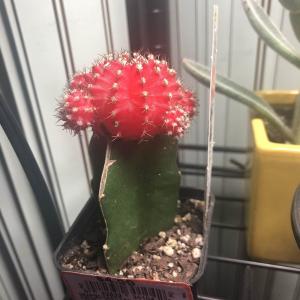
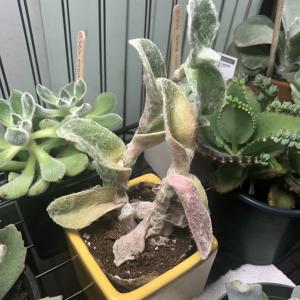


0
0
文章
Miss Chen
2018年05月09日

Description: This herbaceous perennial plant develops 1-2 compound basal leaves during the spring. The blades of these leaves are 3-7" long and 3-7" across; they are ascending to more or less parallel with the ground. Each leaf blade is divided into 3 leaflets (1 terminal & 2 lateral leaflets). In less developed leaves, the leaflets are pinnate-pinnatifid, ultimately dividing into narrow parallel lobes. However, in more developed leaves, each leaflet divides into 3 subleaflets, and these subleaflets are pinnate-pinnatifid, ultimately dividing into narrow lobes. The ultimate lobes of these leaves are ¼–½" long and about 3 mm. (1/8") across; they are linear, linear-elliptic, or linear-oblanceolate in shape with entire (toothless) margins and bluntly acute tips. The upper leaf surface is grayish green to medium green, glabrous, and sometimes slightly glaucous, while the lower leaf surface is white to greenish white, glabrous, and very glaucous. For each compound leaf, the petiolule (basal stalklet) of the terminal leaflet is longer than those of the 2 lateral leaflets. The petioles of the compound leaves are 3-6" long and ascending; they are pale red to pale reddish green, terete, glabrous, and often glaucous.
An inflorescence consisting of a raceme of flowers sometimes develops shortly after the formation of basal leaves. This inflorescence is 6-12" tall and it is either erect or ascending. The peduncle (basal stalk) of the inflorescence is pale red or pale yellowish green, terete, glabrous, and glaucous. Each raceme has 3-10 pendant flowers. The corolla of the pendant flower is ½–¾" long, mostly white, narrowly obcordoid in shape, and somewhat flattened. Two fused outer petals form the rounded nectar spurs (above), the lateral sides, and the pair of of upturned lips (below) of the corolla. Two fused inner petals form a pair of transverse crests and a pair of small inner claws near the entrance of the corolla. The small lips are shaped like keeled hoods with translucent parallel veins. The flat crests are half-cordate in shape, slightly wrinkled, slightly undulate, and white; sometimes they are pinkish along their bases. Inserted within the corolla is a pistil with a single style and several stamens. There are also a pair of tiny sepals; they are about 2-3 mm. long, linear-lanceolate in shape, and light pink with whitish margins. The nodding pedicels of the flowers are pale green or pale reddish green, terete, glabrous, and sometimes glaucous; they are up to ¼" long. At the bases of these pedicels, there are solitary floral bracts about 3-5 mm. long; they are ovate to obovate in shape and light pink with whitish margins.

The blooming period occurs during mid-spring for about 2-3 weeks. The flowers have a sweet fragrance. Afterwards, fertile flowers are replaced by drooping seed capsules that become about 12 mm. (½") long at maturity; these capsules are ovoid in shape and somewhat flattened. Each capsule divides into 2 parts to release its seeds; there are several seeds per capsule. The seeds are 1-2 mm. long, short-reniform in shape, and obscurely reticulate; each seed has an attached elaiosome (food appendage). The foliage dies down by mid-summer. The root system consists of a cluster of yellow globoid corms and fibrous roots.
Cultivation: The preference is dappled sunlight to medium shade, mesic conditions, and a loose loamy soil with decaying organic matter. Growth and development occur during the spring. Germination of the seeds can be slow and difficult, although it may be possible to start new plants by separating some of the corms. Insects and disease organisms are rarely troublesome.

Range & Habitat: The native Squirrel Corn occurs primarily in NE, east-central, and the southern tip of Illinois, where it is uncommon (see Distribution Map). Illinois lies toward the western range limit of this species; it is more common further to the east. Habitats include mesic deciduous woodlands, wooded bluffs, wooded slopes, ravines, and shaded stream banks. Squirrel Corn is found in high quality woodlands in Illinois, where the native ground flora is intact. It is one of the spring wildflowers that is threatened by the invasion of Garlic Mustard (Alliaria petiolata) and some Eurasian shrubs, particularly Amur Honeysuckle (Lonicera maackii).
Faunal Associations: The flowers are cross-pollinated primarily by queen bumblebees. Both nectar and pollen are available as floral rewards. The seeds are distributed to some extent by ants because of their elaisomes (food appendages). Because the foliage is toxic, it is usually avoided by mammalian herbivores. The overall value of this plant to faunal wildlife is low.

Photographic Location: A deciduous woodland at Jim Smith's farm in Vermilion County, Illinois.
Comments: This is another wonderful spring wildflower that can be found in eastern deciduous woodlands. Both the foliage and flowers of Squirrel Corn (Dicentra canadensis) are similar in appearance to those of Dutchman's Breeches (Dicentra cucullaria). Both of these species are found in similar habitats and their blooming periods overlap (Squirrel Corn begins to bloom about 1 week later). However, Dutchman's Breeches is by far the more common wildflower in Illinois. The flowers of Squirrel Corn have short rounded nectar spurs, while those of Dutch's Breeches are longer and more narrow. The basal leaves of these two species are very difficult to distinguish, although those of Squirrel Corn appear to have slightly longer ultimate lobes on average. The corms of these two species are also different in appearance: the corms of Squirrel Corn are yellow and globoid in shape, while the corms of Dutchman's Breeches are pink and more ovoid in shape.
An inflorescence consisting of a raceme of flowers sometimes develops shortly after the formation of basal leaves. This inflorescence is 6-12" tall and it is either erect or ascending. The peduncle (basal stalk) of the inflorescence is pale red or pale yellowish green, terete, glabrous, and glaucous. Each raceme has 3-10 pendant flowers. The corolla of the pendant flower is ½–¾" long, mostly white, narrowly obcordoid in shape, and somewhat flattened. Two fused outer petals form the rounded nectar spurs (above), the lateral sides, and the pair of of upturned lips (below) of the corolla. Two fused inner petals form a pair of transverse crests and a pair of small inner claws near the entrance of the corolla. The small lips are shaped like keeled hoods with translucent parallel veins. The flat crests are half-cordate in shape, slightly wrinkled, slightly undulate, and white; sometimes they are pinkish along their bases. Inserted within the corolla is a pistil with a single style and several stamens. There are also a pair of tiny sepals; they are about 2-3 mm. long, linear-lanceolate in shape, and light pink with whitish margins. The nodding pedicels of the flowers are pale green or pale reddish green, terete, glabrous, and sometimes glaucous; they are up to ¼" long. At the bases of these pedicels, there are solitary floral bracts about 3-5 mm. long; they are ovate to obovate in shape and light pink with whitish margins.

The blooming period occurs during mid-spring for about 2-3 weeks. The flowers have a sweet fragrance. Afterwards, fertile flowers are replaced by drooping seed capsules that become about 12 mm. (½") long at maturity; these capsules are ovoid in shape and somewhat flattened. Each capsule divides into 2 parts to release its seeds; there are several seeds per capsule. The seeds are 1-2 mm. long, short-reniform in shape, and obscurely reticulate; each seed has an attached elaiosome (food appendage). The foliage dies down by mid-summer. The root system consists of a cluster of yellow globoid corms and fibrous roots.
Cultivation: The preference is dappled sunlight to medium shade, mesic conditions, and a loose loamy soil with decaying organic matter. Growth and development occur during the spring. Germination of the seeds can be slow and difficult, although it may be possible to start new plants by separating some of the corms. Insects and disease organisms are rarely troublesome.

Range & Habitat: The native Squirrel Corn occurs primarily in NE, east-central, and the southern tip of Illinois, where it is uncommon (see Distribution Map). Illinois lies toward the western range limit of this species; it is more common further to the east. Habitats include mesic deciduous woodlands, wooded bluffs, wooded slopes, ravines, and shaded stream banks. Squirrel Corn is found in high quality woodlands in Illinois, where the native ground flora is intact. It is one of the spring wildflowers that is threatened by the invasion of Garlic Mustard (Alliaria petiolata) and some Eurasian shrubs, particularly Amur Honeysuckle (Lonicera maackii).
Faunal Associations: The flowers are cross-pollinated primarily by queen bumblebees. Both nectar and pollen are available as floral rewards. The seeds are distributed to some extent by ants because of their elaisomes (food appendages). Because the foliage is toxic, it is usually avoided by mammalian herbivores. The overall value of this plant to faunal wildlife is low.

Photographic Location: A deciduous woodland at Jim Smith's farm in Vermilion County, Illinois.
Comments: This is another wonderful spring wildflower that can be found in eastern deciduous woodlands. Both the foliage and flowers of Squirrel Corn (Dicentra canadensis) are similar in appearance to those of Dutchman's Breeches (Dicentra cucullaria). Both of these species are found in similar habitats and their blooming periods overlap (Squirrel Corn begins to bloom about 1 week later). However, Dutchman's Breeches is by far the more common wildflower in Illinois. The flowers of Squirrel Corn have short rounded nectar spurs, while those of Dutch's Breeches are longer and more narrow. The basal leaves of these two species are very difficult to distinguish, although those of Squirrel Corn appear to have slightly longer ultimate lobes on average. The corms of these two species are also different in appearance: the corms of Squirrel Corn are yellow and globoid in shape, while the corms of Dutchman's Breeches are pink and more ovoid in shape.
0
0
文章
Miss Chen
2018年05月05日

Description: This herbaceous perennial wildflower is 3-7' tall. The stems are light green and hairless, while the large compound leaves are bipinnate or tripinnate with 10 or more leaflets. Usually 3 or 5 leaflets are grouped together in the ultimate partitions of each compound leaf. Individual leaflets are up to 4" long and 3" across; they are medium green, glabrous, and lanceolate to broadly ovate in shape. The margins of these leaflets are coarsely toothed; the terminal leaflets are often shallowly to deeply cleft.
Each plant produces one or more panicles of racemes about 1-3' long. These panicles are very narrow and produce only a few secondary racemes around the central raceme. The racemes are narrowly cylindrical in shape and erect; they are densely covered with flowers, buds, and fruits (follicles) in varying stages of development (buds on top, flowers in the middle, and fruits below). Individual flowers span about 2/3" across and they are completely white, consisting of about 24 stamens, a single pistil, and insignificant sepals that drop early. The slender stamens are long and conspicuous, while the pistil has a short curved tip. Each flower has a short pedicel. The blooming period occurs during early to middle summer and lasts about 1½ months. The flowers have an odd unpleasant scent. Each flower is replaced by a small follicle about 1/3" long; this follicle hasDistribution Map a beak that is very short and usually curved. Each follicle splits open along one side to release several seeds; these seeds are fairly smooth (not conspicuously scaly). The root system is rhizomatous and fibrous.
Cultivation: The preference is partial sun to medium shade, mesic conditions, and a rich loamy soil with abundant organic material. This plant requires plenty of space.
Range & Habitat: The native Black Cohosh is rare in Illinois and state-listed as 'endangered.' It has been found in only a few counties in northern and southern Illinois. At some of these localities, Black Cohosh is probably extirpated because it hasn't observed since the late 19th century. At other localities, the population consists of plants that have been introduced. Habitat includes mesic deciduous woodlands (where Sugar Maple is often dominant) and the bases of bluffs along rivers. In Illinois, Black Cohosh is more common in flower gardens than the wild; it is also more common in natural areas further to the east, including the Appalachian mountains.
Faunal Associations: The flowers provide both nectar and pollen to insect visitors. Unfortunately, these insects are largely unknown, in part because Black Cohosh is uncommon in Illinois and neighboring states. The caterpillars of the butterfly Celastrina neglecta major (Appalachian Azure) feed exclusively on Black Cohosh; however, this insect doesn't occur in Illinois. It is doubtful that mammalian herbivores feed on this wildflower to any significant degree because the foliage is toxic.
Photographic Location: A flower garden at The Arboretum in Urbana, Illinois.
Comments: This is one of the largest woodland wildflowers. Black Cohosh is attractive as a wildflower in part because it produces showy spikes of white flowers during the summer, when there is little else in bloom in wooded habitats. For this reason, it's a pity that this species isn't more common within the state. There are two other species that Black Cohosh can be confused with. One of them, Cimicifuga rubifolia (Appalachian Bugbane), has leaflets up to 10" long and across that often display a maple-leaf shape; it also has fewer than 10 leaflets per compound leaf.

In contrast, Black Cohosh has smaller leaflets (up to 4" long and 3" across) and there are usually more than 10-20 leaflets per compound leaf. Another species, Cimicifuga americana (American Bugbane), has foliage that is nearly identical to that of Black Cohosh. However, American Bugbane has several pistils in the center of each flower, while Black Cohosh has only a single pistil per flower. Similarly, American Bugbane produces its follicles in clusters (one for each pistil), while Black Cohosh produces its follicles individually.
Each plant produces one or more panicles of racemes about 1-3' long. These panicles are very narrow and produce only a few secondary racemes around the central raceme. The racemes are narrowly cylindrical in shape and erect; they are densely covered with flowers, buds, and fruits (follicles) in varying stages of development (buds on top, flowers in the middle, and fruits below). Individual flowers span about 2/3" across and they are completely white, consisting of about 24 stamens, a single pistil, and insignificant sepals that drop early. The slender stamens are long and conspicuous, while the pistil has a short curved tip. Each flower has a short pedicel. The blooming period occurs during early to middle summer and lasts about 1½ months. The flowers have an odd unpleasant scent. Each flower is replaced by a small follicle about 1/3" long; this follicle hasDistribution Map a beak that is very short and usually curved. Each follicle splits open along one side to release several seeds; these seeds are fairly smooth (not conspicuously scaly). The root system is rhizomatous and fibrous.
Cultivation: The preference is partial sun to medium shade, mesic conditions, and a rich loamy soil with abundant organic material. This plant requires plenty of space.
Range & Habitat: The native Black Cohosh is rare in Illinois and state-listed as 'endangered.' It has been found in only a few counties in northern and southern Illinois. At some of these localities, Black Cohosh is probably extirpated because it hasn't observed since the late 19th century. At other localities, the population consists of plants that have been introduced. Habitat includes mesic deciduous woodlands (where Sugar Maple is often dominant) and the bases of bluffs along rivers. In Illinois, Black Cohosh is more common in flower gardens than the wild; it is also more common in natural areas further to the east, including the Appalachian mountains.
Faunal Associations: The flowers provide both nectar and pollen to insect visitors. Unfortunately, these insects are largely unknown, in part because Black Cohosh is uncommon in Illinois and neighboring states. The caterpillars of the butterfly Celastrina neglecta major (Appalachian Azure) feed exclusively on Black Cohosh; however, this insect doesn't occur in Illinois. It is doubtful that mammalian herbivores feed on this wildflower to any significant degree because the foliage is toxic.
Photographic Location: A flower garden at The Arboretum in Urbana, Illinois.
Comments: This is one of the largest woodland wildflowers. Black Cohosh is attractive as a wildflower in part because it produces showy spikes of white flowers during the summer, when there is little else in bloom in wooded habitats. For this reason, it's a pity that this species isn't more common within the state. There are two other species that Black Cohosh can be confused with. One of them, Cimicifuga rubifolia (Appalachian Bugbane), has leaflets up to 10" long and across that often display a maple-leaf shape; it also has fewer than 10 leaflets per compound leaf.

In contrast, Black Cohosh has smaller leaflets (up to 4" long and 3" across) and there are usually more than 10-20 leaflets per compound leaf. Another species, Cimicifuga americana (American Bugbane), has foliage that is nearly identical to that of Black Cohosh. However, American Bugbane has several pistils in the center of each flower, while Black Cohosh has only a single pistil per flower. Similarly, American Bugbane produces its follicles in clusters (one for each pistil), while Black Cohosh produces its follicles individually.
0
0
文章
权问薇
2018年05月01日

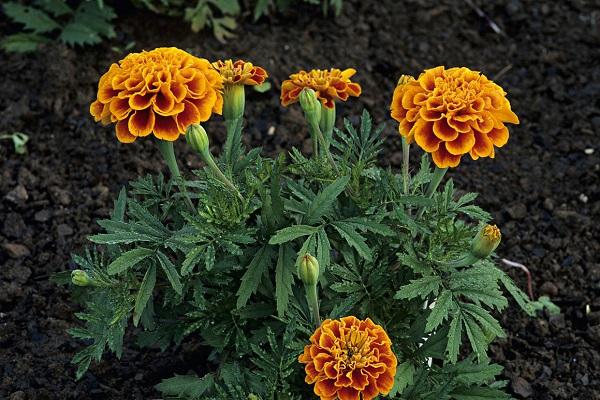
1、移栽期间浇水
确定移栽时间后,可以提前7天断水。这样同样也是为了防止它的徒长,同时更有利于移栽的成功,提高花儿的质量。这一点非常重要,友友们想要栽种出质量较好的万寿菊,就必须有遵守这一点。移栽后3天左右就可以正常浇水了。

2、高温期间浇水
高温期间通常说的就是炎热的夏季,大部分植物在夏季则需要大量的水分来维持,因温度较高时,水的流失也较严重。但是此植物在高温期间则需要让土壤维持在偏干状态最好,因为此时若是水分过多,很容易让植物徒长,除了会影响株型外,还会使花期延后或是花的质量不佳。所以此时一定要严格控制浇水。

3、其它期间浇水
它的浇水原则是间干间湿,所以日常浇水时可以等到土壤表层已经干透后在进行浇水。此植物既喜水又抗旱,所以当其土壤表层已经干透后在浇水也是可以的。但喜水并不代表浇水时可以出现积水,或是让花土长期处在潮湿的状态下。所用花土的透水性与透气性一定要好。这样有利于植物的健康,也简化了植物养殖的难度。

0
0
文章
权问薇
2018年04月28日

剪1串珠子扔土里,呼呼长成绿帘子
成串的佛珠就像窗帘子似的,悬挂在家里真的好美啊,想让佛珠一盆变多盆,就得学花花这么做!

1、剪下佛珠串
剪下佛珠翠绿健康的枝条,一般5-7珠子为一串。一定要注意每段都要有根结才能成活,就是小凸起。

2、再剪掉2个珠子
再把每串佛珠一头的2个珠子剪掉,留出较长的茎部,可以深埋到土里。把枝条放到通风阴凉处,晾干伤口。
3、配土
土壤用珍珠岩或者河沙,可以提高透水透气性,防止腐烂。

4、枝条插入土中
把枝条插入土里,要用土埋的深一些,防止后期枝条变长变重,把佛珠连根拔起。最后浇1次透水,放到散射光下。等土干了就浇水,一般7-15天就会生根了。
5、这么养护,呼呼长成绿帘子
春天比较干燥,可以每天往珠子周围喷水,也可以每个月喷点稀释的磷酸二氢钾,让珠子长得更加圆润饱满。挂在客厅,亲戚朋友来了看到后肯定羡慕极了!
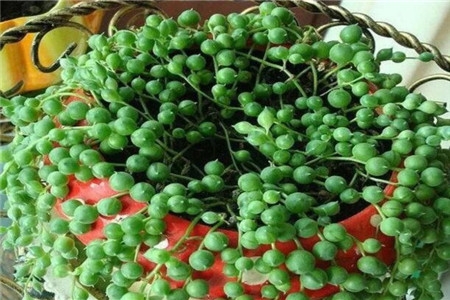
掰1片叶子扔土里,嗖嗖窜满盆
平时不小心碰掉了肉肉的叶子,花友们就会很心疼,其实完全没必要心疼哦,把1片叶子扔土里,就能呼呼生根窜新芽,想养100盆都没问题!来看看花花是咋做的!

1、挑选健康的叶子
选择健康饱满的叶子,尽量别选发黄、病虫害等不健康的叶子,不但成活率低,还会感染其他叶片哦。放到阴凉通风处晾干伤口。

2、配土
叶插的土壤可以用蛭石或者河沙等透气性比较好的土,避免烂根。然后用喷壶朝土壤表面喷洒,让土壤保持潮湿。
3、叶子斜插到土里
先找一个小木棍,在土里戳一个小坑,然后把晾干伤口的叶片斜着放入小坑里,轻轻用土掩埋,放到散射光下。

4、15天后生根
一般等15天后,叶片就生出大白根啦,要保持土壤潮湿,经常往土壤表面喷水。生根之后可以适当增加光照强度。
5、30天后,呼呼冒侧芽
等30天后,肉肉就会长出侧芽了,新芽越长越大,避免阳光直射,土干了再浇水。让老叶片自己慢慢枯萎脱落,不要用手摘掉,防止伤害新芽和根系。

剪个枝扔水里,呼呼冒出大白根
想让肉肉一盆变100盆,还有一个更简便的方法,那就是扔水里诱根,既卫生又高效,快来看看咋做的!
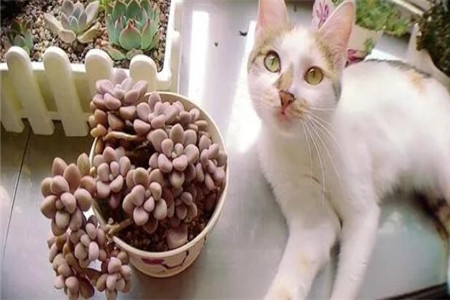
1、剪下健壮枝条
挑选肉肉健壮饱满的枝条,剪下来之后放到通风好的地方,先让伤口晾干。

2、浸泡在白糖水中,促进生根
先把白糖和热水按照1:10的比例融化,等白糖水彻底凉透之后,把肉肉枝条放到白糖水里,浸泡20分钟后拿出来用清水冲洗一下,再晾干伤口。
3、插清水里
找一个干净的瓶子,往里边倒入2/3的清水,然后把肉肉枝条放入水中。放到散射光、通风好的地方。

4、1-2周就生根啦
大概1-2周后,就会看到肉肉生出大白根啦。
5、移栽到土里
等根系长到2厘米的时候,先取出来稍微晾一下根部的水,然后就可以上盆啦!这种水培方法可以大大提高生根率哦。

肉肉扦插方法,你试过几种呀?
趁着春天赶紧扦插吧!错过得再等1年哦!如果觉得方法还不错,就分享给朋友们吧!
成串的佛珠就像窗帘子似的,悬挂在家里真的好美啊,想让佛珠一盆变多盆,就得学花花这么做!

1、剪下佛珠串
剪下佛珠翠绿健康的枝条,一般5-7珠子为一串。一定要注意每段都要有根结才能成活,就是小凸起。

2、再剪掉2个珠子
再把每串佛珠一头的2个珠子剪掉,留出较长的茎部,可以深埋到土里。把枝条放到通风阴凉处,晾干伤口。
3、配土
土壤用珍珠岩或者河沙,可以提高透水透气性,防止腐烂。

4、枝条插入土中
把枝条插入土里,要用土埋的深一些,防止后期枝条变长变重,把佛珠连根拔起。最后浇1次透水,放到散射光下。等土干了就浇水,一般7-15天就会生根了。
5、这么养护,呼呼长成绿帘子
春天比较干燥,可以每天往珠子周围喷水,也可以每个月喷点稀释的磷酸二氢钾,让珠子长得更加圆润饱满。挂在客厅,亲戚朋友来了看到后肯定羡慕极了!

掰1片叶子扔土里,嗖嗖窜满盆
平时不小心碰掉了肉肉的叶子,花友们就会很心疼,其实完全没必要心疼哦,把1片叶子扔土里,就能呼呼生根窜新芽,想养100盆都没问题!来看看花花是咋做的!

1、挑选健康的叶子
选择健康饱满的叶子,尽量别选发黄、病虫害等不健康的叶子,不但成活率低,还会感染其他叶片哦。放到阴凉通风处晾干伤口。

2、配土
叶插的土壤可以用蛭石或者河沙等透气性比较好的土,避免烂根。然后用喷壶朝土壤表面喷洒,让土壤保持潮湿。
3、叶子斜插到土里
先找一个小木棍,在土里戳一个小坑,然后把晾干伤口的叶片斜着放入小坑里,轻轻用土掩埋,放到散射光下。

4、15天后生根
一般等15天后,叶片就生出大白根啦,要保持土壤潮湿,经常往土壤表面喷水。生根之后可以适当增加光照强度。
5、30天后,呼呼冒侧芽
等30天后,肉肉就会长出侧芽了,新芽越长越大,避免阳光直射,土干了再浇水。让老叶片自己慢慢枯萎脱落,不要用手摘掉,防止伤害新芽和根系。

剪个枝扔水里,呼呼冒出大白根
想让肉肉一盆变100盆,还有一个更简便的方法,那就是扔水里诱根,既卫生又高效,快来看看咋做的!

1、剪下健壮枝条
挑选肉肉健壮饱满的枝条,剪下来之后放到通风好的地方,先让伤口晾干。

2、浸泡在白糖水中,促进生根
先把白糖和热水按照1:10的比例融化,等白糖水彻底凉透之后,把肉肉枝条放到白糖水里,浸泡20分钟后拿出来用清水冲洗一下,再晾干伤口。
3、插清水里
找一个干净的瓶子,往里边倒入2/3的清水,然后把肉肉枝条放入水中。放到散射光、通风好的地方。

4、1-2周就生根啦
大概1-2周后,就会看到肉肉生出大白根啦。
5、移栽到土里
等根系长到2厘米的时候,先取出来稍微晾一下根部的水,然后就可以上盆啦!这种水培方法可以大大提高生根率哦。

肉肉扦插方法,你试过几种呀?
趁着春天赶紧扦插吧!错过得再等1年哦!如果觉得方法还不错,就分享给朋友们吧!
0
1
文章
Miss Chen
2018年04月24日

Description: This perennial plant is about 3-7' tall and usually unbranched, except near the inflorescence. The central stem is light green or purplish green, terete, and nearly glabrous to pubescent. The alternate leaves are densely to moderately distributed along the stem, spreading widely in all directions. These leaves are up to 9" long and 2½" across; they are narrowly ovate, lanceolate-oblong, or elliptic in shape, and their margins are serrated. The upper surface of each leaf is dark green and glabrous (or nearly so); the lower surface is a lighter shade of green and glabrous, sparsely pubescent, or somewhat hairy. The base of each leaf has a short petiole, or it is sessile.
The central stem terminates in a flat-headed panicle of flowerheads spanning 6-16" across. The base of each flowerhead consists of a short cylinder of appressed floral bracts (phyllaries) in several series spanning about 5 mm. across; the floral bracts are dark green, purplish green, or brown, broadly ovate in shape, and often finely pubescent or ciliate along their margins. The apex of each flowerhead consists of 10-30 disk florets and no ray florets. The magenta corolla of each disk floret is tubular with 5 recurved narrow lobes, while the exerted style is bifurcated and strongly recurved. The branches of the panicle and peduncles of the flowerheads are usually finely short-pubescent. The blooming period occurs from late summer to early fall and lasts about 1–1½ months. There is no noticeable floral scent. Each disk floret is replaced by a small achene that is gray or brown and bullet-shaped; the apex of each achene has a small tuft of both short and long hair hairs (or bristles) that are pale purple to tawny. These achenes are distributed by the wind. The root system consists of short thick rhizomes with fibrous roots below. Small clumps of plants are produced from the rhizomes.

Cultivation: The preference is full sun to light shade, moist to mesic conditions, and soil containing loam, clay-loam, silt-loam, or sandy loam. Plants growing in sunny areas require more moisture than those growing in the shade.
Range & Habitat: The native Tall Ironweed is common in southern Illinois, while in the rest of the state it is occasional to absent (see Distribution Map). Habitats include open woodlands, woodland borders, thickets, areas along woodland paths, swamps, riverbottom prairies, seeps and springs, pastures, and abandoned fields. In woodlands, this plant requires occasional disturbance to prevent excessive shade from neighboring trees. Tall Ironweed is found in wooded areas to a greater extent than other Vernonia spp. (Ironweed species) in Illinois, but it also occurs in moist open areas.

Faunal Associations: The nectar of the flowers attracts bee flies, butterflies, skippers, and various bees (primarily long-tongued bees). Some bees also collect pollen for their larvae. The caterpillars of various moths feed on Vernonia spp. (Ironweed species), particularly the pith of their stems and their roots. These species include Carmenta bassiformis (Eupatorium Borer Moth), Papaipema cerussata (Ironweed Borer Moth), Papaipema limpida (another Ironweed Borer Moth), Perigea xanthioides (Red Groundling), Polygrammodes flavidalis (Pyralid Moth sp.), and Polygrammodes langdonalis (Pyralid Moth sp.). Another insect, Aphis vernoniae (Ironweed Aphid), sucks juices from the upper stems and leaf undersides. Other insects feeders include the larvae of Asphondylia vernoniae (Ironweed Bud Midge) and Youngomyia podophyllae (Ironweed Blossum Midge), which form galls on the buds and flowerheads respectively. Both Oecanthus quadripunctatus (Four-Spotted Tree Cricket) and Conocephalus brevipennis (Short-winged Meadow Katydid) have been observed feeding on the flowerheads of Tall Ironweed (Gangwere, 1961). Because of the bitter foliage, mammalian herbivores shun Ironweed species as a food source. As a result, these plants can become more abundant in pastures over time.

Photographic Location: The edge of a small woodland in Urbana, Illinois.
Comments: Across its range, Tall Ironweed is a rather variable species. Different populations of plants can vary in the number of disk florets per flowerhead, the width of the leaves, and the hairiness of the stems and leaf undersides. Tall Ironweed also hybridizes with other Vernonia spp. (Ironweeds), especially Vernonia missurica (Missouri Ironweed). The latter hybrid is referred to as Vernonia × illinoensis (Illinois Ironweed). Illinois Ironweed typically has flowerheads with 30-35 disk florets and is more hairy than Tall Ironweed. Missouri Ironweed has flowerheads with 35-50 disk florets and it is more hairy than Tall Ironweed; both stems and leaf undersides of Missouri Ironweed are often white-woolly from the abundance of these hairs. Another species, Vernonia fasciculata (Smooth Ironweed), has about the same number of disk florets in its flowerheads as Tall Ironweed (less than 30), but it is usually smaller in size and its stems are hairless. Unlike Tall Ironweed, Smooth Ironweed often has dark dots on the underside of its hairless leaves. A scientific synonym of Tall Ironweed is Vernonia altissima.
The central stem terminates in a flat-headed panicle of flowerheads spanning 6-16" across. The base of each flowerhead consists of a short cylinder of appressed floral bracts (phyllaries) in several series spanning about 5 mm. across; the floral bracts are dark green, purplish green, or brown, broadly ovate in shape, and often finely pubescent or ciliate along their margins. The apex of each flowerhead consists of 10-30 disk florets and no ray florets. The magenta corolla of each disk floret is tubular with 5 recurved narrow lobes, while the exerted style is bifurcated and strongly recurved. The branches of the panicle and peduncles of the flowerheads are usually finely short-pubescent. The blooming period occurs from late summer to early fall and lasts about 1–1½ months. There is no noticeable floral scent. Each disk floret is replaced by a small achene that is gray or brown and bullet-shaped; the apex of each achene has a small tuft of both short and long hair hairs (or bristles) that are pale purple to tawny. These achenes are distributed by the wind. The root system consists of short thick rhizomes with fibrous roots below. Small clumps of plants are produced from the rhizomes.

Cultivation: The preference is full sun to light shade, moist to mesic conditions, and soil containing loam, clay-loam, silt-loam, or sandy loam. Plants growing in sunny areas require more moisture than those growing in the shade.
Range & Habitat: The native Tall Ironweed is common in southern Illinois, while in the rest of the state it is occasional to absent (see Distribution Map). Habitats include open woodlands, woodland borders, thickets, areas along woodland paths, swamps, riverbottom prairies, seeps and springs, pastures, and abandoned fields. In woodlands, this plant requires occasional disturbance to prevent excessive shade from neighboring trees. Tall Ironweed is found in wooded areas to a greater extent than other Vernonia spp. (Ironweed species) in Illinois, but it also occurs in moist open areas.

Faunal Associations: The nectar of the flowers attracts bee flies, butterflies, skippers, and various bees (primarily long-tongued bees). Some bees also collect pollen for their larvae. The caterpillars of various moths feed on Vernonia spp. (Ironweed species), particularly the pith of their stems and their roots. These species include Carmenta bassiformis (Eupatorium Borer Moth), Papaipema cerussata (Ironweed Borer Moth), Papaipema limpida (another Ironweed Borer Moth), Perigea xanthioides (Red Groundling), Polygrammodes flavidalis (Pyralid Moth sp.), and Polygrammodes langdonalis (Pyralid Moth sp.). Another insect, Aphis vernoniae (Ironweed Aphid), sucks juices from the upper stems and leaf undersides. Other insects feeders include the larvae of Asphondylia vernoniae (Ironweed Bud Midge) and Youngomyia podophyllae (Ironweed Blossum Midge), which form galls on the buds and flowerheads respectively. Both Oecanthus quadripunctatus (Four-Spotted Tree Cricket) and Conocephalus brevipennis (Short-winged Meadow Katydid) have been observed feeding on the flowerheads of Tall Ironweed (Gangwere, 1961). Because of the bitter foliage, mammalian herbivores shun Ironweed species as a food source. As a result, these plants can become more abundant in pastures over time.

Photographic Location: The edge of a small woodland in Urbana, Illinois.
Comments: Across its range, Tall Ironweed is a rather variable species. Different populations of plants can vary in the number of disk florets per flowerhead, the width of the leaves, and the hairiness of the stems and leaf undersides. Tall Ironweed also hybridizes with other Vernonia spp. (Ironweeds), especially Vernonia missurica (Missouri Ironweed). The latter hybrid is referred to as Vernonia × illinoensis (Illinois Ironweed). Illinois Ironweed typically has flowerheads with 30-35 disk florets and is more hairy than Tall Ironweed. Missouri Ironweed has flowerheads with 35-50 disk florets and it is more hairy than Tall Ironweed; both stems and leaf undersides of Missouri Ironweed are often white-woolly from the abundance of these hairs. Another species, Vernonia fasciculata (Smooth Ironweed), has about the same number of disk florets in its flowerheads as Tall Ironweed (less than 30), but it is usually smaller in size and its stems are hairless. Unlike Tall Ironweed, Smooth Ironweed often has dark dots on the underside of its hairless leaves. A scientific synonym of Tall Ironweed is Vernonia altissima.
0
0
文章
Miss Chen
2018年04月23日

Description: This perennial plant is 3-7' tall and usually unbranched, although short stems may develop from the leaf axils. The central stem is light green and stout; it has several flat ridges that are separated by narrow channels. The central stem is sparsely covered with stiff white hairs of variable length; these hairs can penetrate the skin and sting. Along the central stem are pairs of opposite leaves that droop downward slightly. The leaf blades are up to 8" long and 2½" across; they are medium to dark green, lanceolate, and coarsely serrated. The base of each leaf blade is rounded or slightly cordate. The upper surface of each leaf blade is heavily veined and glabrous, while the lower surface has sparse stiff hairs that can also sting. The slender petioles of the leaves are up to 1" long. At the base of each petiole, there is a pair of stipules up to ½" long.
Panicles of flowers develop from the axils of the middle to upper leaves. These panicles are much branched and droop downward; their pubescent branches are heavily covered with flowers. Slender Nettle is monoecious to slightly dioecious; some plants have male flowers entirely or predominantly, while other plants have female flowers entirely or predominately. The male flowers are 1/8" (3 mm.) across with 4 green sepals and 4 white stamens. The female flowers are 1/8" across with 4 green sepals; the 2 inner sepals that enclose the ovary are larger in size than the 2 outer sepals. The sepals of both male and female flowers are pubescent; neither kind of flower has petals. The blooming period occurs during the summer and can last 1-2 months for a colony of plants. Pollination of the flowers is by wind. The brown seeds are 1.0–1.5 mm. long and irregular in shape. They can remain viable in the ground for 10 years. The root system is fibrous and rhizomatous. Clonal colonies are often produced from the long rhizomes.

Cultivation: The preference is partial sun to light shade, moist to mesic conditions, and a fertile loamy soil. Most growth occurs during late spring and mid-summer. This plant can spread aggressively in favorable situations. The leaves are often attacked by insects.
Range & Habitat: The native Slender Nettle is occasional to locally common in central and northern Illinois, while in the southern section of the state it is uncommon or absent (see Distribution Map). Habitats include disturbed open woodlands, floodplain woodlands, woodland borders, thickets, meadows in wooded areas, partially shaded seeps, fence rows, and moist waste areas. Areas with a history of disturbance are preferred.

Faunal Associations: Caterpillars of the butterflies Vanessa atalanta (Red Admiral), Nymphalis milberti (Milbert's Tortoiseshell), Polygonia comma (Comma), and Polygonia interrogationis (Question Mark) feed on the foliage of Urtica spp. (nettles). Other insects that feed on nettles include leaf-mining larvae of the beetle Sumitrosis inaequalis, stem-boring larvae of the lizard beetle Acropteroxys gracilis, leaf-mining larvae of the midge Agromyza subnigripes, larvae of Dasineura urnicola (Nettle Urn Gall Midge), larvae of the moth Glyphipterix quadragintapunctata, and the leafhopper Empoasca vergena. The presence of stinging hairs in nettles provides some protection from the browsing of mammalian herbivores. Because Slender Nettle is relatively tall and often forms clonal colonies, it provides cover and protection for various insects, mammals, and birds.
Photographic Location: The edge of a woodland in Urbana, Illinois.

Comments: Slender Nettle is less heavily armed with stinging hairs than Urtica dioica (Stinging Nettle) and Laportea canadensis (Wood Nettle). Sometimes Slender Nettle is regarded as a variety of Stinging Nettle, in which case it is referred to as Urtica dioica gracilis. Stinging Nettle is adventive from Eurasia and has rarely naturalized in Illinois. It is shorter in stature and has wider leaves than Slender Nettle. The native Wood Nettle is similar in appearance to Stinging Nettle, except that it has alternate leaves. Unfortunately, these 3 species are often confused with each other. While many people dislike Urtica spp. (Nettles) and similar species because of their stinging hairs, they are important food plants to several species of butterflies. The young leaves of Nettles are edible if they are boiled in water and transformed into a creamy soup; they are supposed to be an excellent source of several vitamins and minerals.
Panicles of flowers develop from the axils of the middle to upper leaves. These panicles are much branched and droop downward; their pubescent branches are heavily covered with flowers. Slender Nettle is monoecious to slightly dioecious; some plants have male flowers entirely or predominantly, while other plants have female flowers entirely or predominately. The male flowers are 1/8" (3 mm.) across with 4 green sepals and 4 white stamens. The female flowers are 1/8" across with 4 green sepals; the 2 inner sepals that enclose the ovary are larger in size than the 2 outer sepals. The sepals of both male and female flowers are pubescent; neither kind of flower has petals. The blooming period occurs during the summer and can last 1-2 months for a colony of plants. Pollination of the flowers is by wind. The brown seeds are 1.0–1.5 mm. long and irregular in shape. They can remain viable in the ground for 10 years. The root system is fibrous and rhizomatous. Clonal colonies are often produced from the long rhizomes.

Cultivation: The preference is partial sun to light shade, moist to mesic conditions, and a fertile loamy soil. Most growth occurs during late spring and mid-summer. This plant can spread aggressively in favorable situations. The leaves are often attacked by insects.
Range & Habitat: The native Slender Nettle is occasional to locally common in central and northern Illinois, while in the southern section of the state it is uncommon or absent (see Distribution Map). Habitats include disturbed open woodlands, floodplain woodlands, woodland borders, thickets, meadows in wooded areas, partially shaded seeps, fence rows, and moist waste areas. Areas with a history of disturbance are preferred.

Faunal Associations: Caterpillars of the butterflies Vanessa atalanta (Red Admiral), Nymphalis milberti (Milbert's Tortoiseshell), Polygonia comma (Comma), and Polygonia interrogationis (Question Mark) feed on the foliage of Urtica spp. (nettles). Other insects that feed on nettles include leaf-mining larvae of the beetle Sumitrosis inaequalis, stem-boring larvae of the lizard beetle Acropteroxys gracilis, leaf-mining larvae of the midge Agromyza subnigripes, larvae of Dasineura urnicola (Nettle Urn Gall Midge), larvae of the moth Glyphipterix quadragintapunctata, and the leafhopper Empoasca vergena. The presence of stinging hairs in nettles provides some protection from the browsing of mammalian herbivores. Because Slender Nettle is relatively tall and often forms clonal colonies, it provides cover and protection for various insects, mammals, and birds.
Photographic Location: The edge of a woodland in Urbana, Illinois.

Comments: Slender Nettle is less heavily armed with stinging hairs than Urtica dioica (Stinging Nettle) and Laportea canadensis (Wood Nettle). Sometimes Slender Nettle is regarded as a variety of Stinging Nettle, in which case it is referred to as Urtica dioica gracilis. Stinging Nettle is adventive from Eurasia and has rarely naturalized in Illinois. It is shorter in stature and has wider leaves than Slender Nettle. The native Wood Nettle is similar in appearance to Stinging Nettle, except that it has alternate leaves. Unfortunately, these 3 species are often confused with each other. While many people dislike Urtica spp. (Nettles) and similar species because of their stinging hairs, they are important food plants to several species of butterflies. The young leaves of Nettles are edible if they are boiled in water and transformed into a creamy soup; they are supposed to be an excellent source of several vitamins and minerals.
0
0


